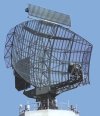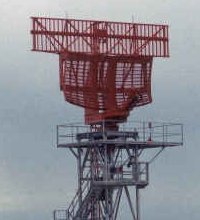Air Traffic Control Radar
Gallerie of different ATC-Radars

Fig. 1: SRE-M7, a typically en-route radar made by the German DASA company

Fig. 2: The Air Surveillance Radar ASR-12 of Northrop/Grumman

Fig. 3: Precision Approach Radar PAR-80 made by ITT
Air Traffic Control Radar
Air Traffic Control Radar (ATC-Radar) is the umbrella term for all radar devices used to secure and monitor civil and military air traffic in Air Traffic Management (ATM). They are usually fixed radar systems that have a high degree of specialization. Common applications of air traffic control radars include:
- en-route radar systems,
- Air Surveillance Radar (ASR) systems,
- Precision Approach Radar (PAR) systems,
- surface movement radars, and
- special weather radars.
En-Route Radars
En-Route Radars monitor the air traffic outside the special airfield areas. En-route radar systems operate in the NATO D-Band usually. These radar sets initially detect and determine the position, course, and speed of air targets in a relatively large area up to 250 nm. En-route radars are Primary Surveillance Radars (PSR) that are coupled to a Secondary Surveillance Radar (SSR).
Air Surveillance Radar (ASR)
Airport Surveillance Radar (ASR) is an approach control radar used to detect and display an aircraft's position in the terminal area. These radar sets operate usually in E-Band and are capable of reliably detecting and tracking aircraft at altitudes below 25,000 feet (7,620 meters) and within 40 to 60 nautical miles (75 to 110 km) of their airport. The antennas of ASR rotate faster at 12 to 15 revolutions per minute to ensure the required data renewal rate of up to 5 seconds. Modern ASR have an additional weather channel and can clear up dangerous for aviation weather conditions.
Precision Approach Radar (PAR)
The ground-controlled approach is a control mode in which an aircraft is able to land in bad weather conditions. The pilot is guided by ground control using Precision Approach Radar (PAR). The guidance information is obtained by the radar operator and passed to the aircraft by either voice radio or a computer link to the aircraft. These radar sets operate usually in I-Band.
Surface Movement Radar (SMR)
The Surface Movement Radar (SMR) scans the airport surface to locate the positions of aircraft and ground vehicles and displays them for air traffic controllers in bad weather. Surface movement radars operate in I- to K-Band and use an extremely short pulse-width to provide an acceptable range-resolution. The range is limited to a few kilometers, the antenna rotation speed is 60 revolutions per minute.
Specially weather-radar applications
Weather radar is very important for air traffic management. There are weather-radars specially designed for air traffic safety.


